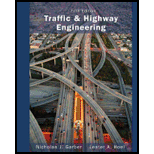
Traffic And Highway Engineering
5th Edition
ISBN: 9781133605157
Author: Garber, Nicholas J., Hoel, Lester A.
Publisher: Cengage Learning,
expand_more
expand_more
format_list_bulleted
Question
thumb_up100%
Chapter 15, Problem 19P
To determine
(a)
The minimum radius of horizontal curvature for given conditions.
To determine
(b)
The minimum length of crest vertical curves.
To determine
(c)
The minimum length of sag vertical curves.
Expert Solution & Answer
Want to see the full answer?
Check out a sample textbook solution
Students have asked these similar questions
Part 3: Problem-Solving. Solve the following problems. Show all calculations.
1. A retaining wall 5.80m high supports soil that has the following properties:
Unit weight = 17.3 kN/m³
Angle of internal friction = 26 deg.
Cohesion = 14.5 kPa
a) Calculate the normal pressure acting at the back of the wall assuming no tensile crack
occurs in the soil.
b) Find the location of the tensile crack measured from the surface of horizontal backfill.
c) Determine the active pressure acting on the wall in tensile crack occurs in the soil.
2. The soil material is supported by a retaining wall to a height of 6m. The unit weight of the soil is
16 kN/m³ and the angle of internal friction is 29 deg. Assume the soil is cohesionless.
a) Determine the earth pressure on the wall.
b) Find the total active pressure if surcharge of 14 kPa is applied on the surface of
horizontal backfill.
c) Locate the position of the total pressure from the bottom.
Question 3 (20 points): The traffic volume on a 2-lane highway is 1600 veh/hr in each direction
Page 3 of 6
with a density of 20 veh/mi. A large dump truck enters the traffic stream from an adjacent
construction site at 20 mph and carries on this way for 2 miles before turning off to the dump
site. Because flow is so high in the opposite direction, no one can pass the truck. As a result,
traffic back up behind the truck at four times the density (i.e., 4x20 = 80 veh/mi) at a volume of
1000 veh/hr. How many vehicles get caught in the traffic congestion before the truck exits the
highway?
How can construction project managers find a balance between speeding up schedules and the risks of making more mistakes and needing rework, especially when using methods like fast tracking?
Chapter 15 Solutions
Traffic And Highway Engineering
Knowledge Booster
Similar questions
- What are the total earned work hours at completion for the column forms?arrow_forward6000 units have been installed to date with 9,000 units to install. Labor costs are $23,300.00 to date. What is the unit cost for labor to date?arrow_forwardThe base rate for labor is $15/hr. The labor burden is 35% and 3% for small tools for the labor. There are 1000 units to install. Records indicate that trade workers can install 10 units per hour, per trade worker. The owners need 15% overhead and profit to pay bills, pay interest on loan and provide some profit to the partners. What is the minimum bid assuming no risk avoidance factor?arrow_forward
- 5. (20 Points) Consider a channel width change in the same 7-foot wide rectangular in Problem 4. The horizontal channel narrows as depicted below. The flow rate is 90 cfs, and the energy loss (headloss) through the transition is 0.05 feet. The water depth at the entrance to the transition is initially 4'. 1 b₁ TOTAL ENERGY LINE V² 129 У1 I b₂ TOP VIEW 2 PROFILE VIEW h₁ = 0.05 EGL Y₂ = ? a) b) c) 2 Determine the width, b₂ that will cause a choke at location 2. Determine the water depth at the downstream end of the channel transition (y₂) section if b₂ = 5 feet. Calculate the change in water level after the transition. Plot the specific energy diagram showing all key points. Provide printout in homework. d) What will occur if b₂ = = 1.5 ft.?arrow_forward4. (20 Points) A transition section has been proposed to raise the bed level a height Dz in a 7-foot wide rectangular channel. The design flow rate in the channel is 90 cfs, and the energy loss (headloss) through the transition is 0.05 feet. The water depth at the entrance to the transition section is initially 4 feet. b₁ = b = b2 1 TOTAL ENERGY LINE V² 129 Ут TOP VIEW 2 hloss = 0.05 " EGL Y₂ = ? PROFILE VIEW a) Determine the minimum bed level rise, Dz, which will choke the flow. b) If the step height, Dz = 1 ft, determine the water depth (y2) at the downstream end of the channel transition section. Calculate the amount the water level drops or rises over the step. c) Plot the specific energy diagram showing all key points. Provide printout in Bework. d) What will occur if Dz = 3.0 ft.?. Crest Front Viewarrow_forward1. (20 Points) Determine the critical depth in the trapezoidal drainage ditch shown below. The slope of the ditch is 0.0016, the side slopes are 1V:2.5H, the bottom width is b = 14', and the design discharge is 500 cfs. At this discharge the depth is y = 4.25'. Also, determine the flow regime and calculate the Froude number. Ye= ? Z barrow_forward
arrow_back_ios
SEE MORE QUESTIONS
arrow_forward_ios
Recommended textbooks for you
 Traffic and Highway EngineeringCivil EngineeringISBN:9781305156241Author:Garber, Nicholas J.Publisher:Cengage Learning
Traffic and Highway EngineeringCivil EngineeringISBN:9781305156241Author:Garber, Nicholas J.Publisher:Cengage Learning

Traffic and Highway Engineering
Civil Engineering
ISBN:9781305156241
Author:Garber, Nicholas J.
Publisher:Cengage Learning